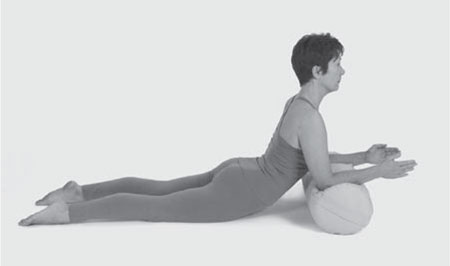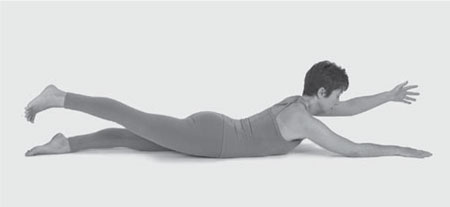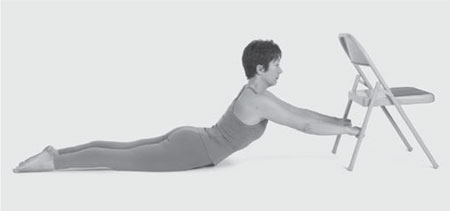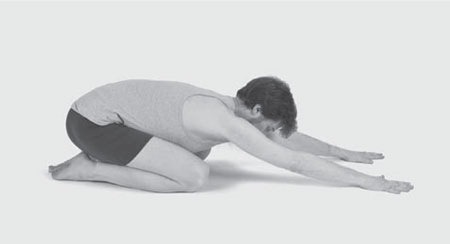Yoga for a Healthy Lower Back (21 page)
Read Yoga for a Healthy Lower Back Online
Authors: Liz Owen

â¢Â  Stretch your legs and torso away from your waist to create length for your back.
â¢Â  Bring your hips to neutral position, and draw your tailbone down toward the floor while you engage your buttock muscles. Your buttock muscles should be firm (but not tightly gripped) so your sacral joints feel stable.
â¢Â  Lengthen your frontal hip bones toward your waist. You will feel this action as you draw your tailbone down, but if you are unsure, place your fingers on your frontal hip bones, and draw them up your body. You will feel length in your front groins and thighs.
â¢Â  Remember what we learned earlier, that your sacral bone nutatesâit naturally moves forward toward your front body as your spine comes into a backbend. You can help create room for your lower back to move into a backbend comfortably by consciously elongating your lower back and waist forward before lifting them up into a back-bending position.
â¢Â  If the floor creates discomfort in your frontal hips, lie on a folded blanket.
Supported Cobra Pose
Strengthen | Salamba Bhujangasana
Lie on your front body and place a bolster or two stacked, folded blankets crosswise in front of you. Place your forearms on the bolster and draw your torso right up to the bolster. As you move, engage your buttock muscles while you draw your tailbone toward the floor; engage your leg muscles and abdominal core. Press your forearms down and lift your torso up so your breastbone is high and your collarbones are wide (
fig. 3.14
). Imagine you are able to lift your heart higher than your breastbone. Draw your shoulder blades away from your ears and press them forward to help support your chest. Pressing your forearms on the bolster helps elongate and lift your spine, especially at the meeting place of your sacral and lumbar spines, where it tends to overarch and compress in traditional Cobra Pose. If your sacral band feels achy, practice the pose without the bolster, placing your forearms and hands on the floor and lifting your torso up only as much as is comfortable in your lower back.

FIG. 3.14
Supported Cobra Pose is very therapeutic for weak or imbalanced sacral joints. The support that the actions of your buttock muscles and abdominal core provide helps to draw your sacral joints toward your front body and “reset” them into a balanced position. It feels particularly soothing if you have sprained your sacral band. If your body likes Supported Cobra, hold it for a few minutes.
Your body will tell you when it is time to come out of Supported Cobra Pose. If your back starts to ache or feel compressed, it is time to release the pose. Move the bolster away from your body and rest with your head on your hands for a few breaths. Bend your legs, point your toes up to the ceiling, and sway your shins from side to side, feeling gentle movement come into your hips and sacral band. Press your hands into the floor and lift your shoulders and hips up, coming onto your hands and knees. Then move into
Child's Pose
for a few breaths.
Alternate Arm/Leg Prone Backbend
Strengthen | Shalabhasana Variation
Lie on your front body with your legs and arms stretched away from your torso. Place your feet about hips' distance apart and place your hands shoulders' width apart. Rest the center of your forehead or your chin on the floor, whichever is more comfortable for your neck. Place a pillow under your abdomen if your lower back is uncomfortable.
Press your tailbone down toward the floor and firm your buttock muscles. Feel your hips balanced and equally grounded. As you inhale, lift your right leg up while keeping your hips even. Press your right hand down into the floor and lift your left arm and shoulder up (
fig. 3.15
). Stretch your right leg and left arm away from each other, creating as much length along the diagonal of your body as you can. Keep your hips grounded on the floorâno tipping to one side or the other. Hold for about fifteen seconds and release your leg and arm down. Repeat three or four times on the same side, rest for a few breaths, and repeat the pose an equal number of times on your opposite side. When you are done, fold your forearms and rest your forehead on your hands.

FIG. 3.15
The muscular work of lifting your right leg and left arm goes directly through your right sacral joint, stimulating and strengthening the myofascia around the buttocks while your hips are in a supported, stable position. Energetically speaking, this work goes directly through the Svadhisthana (sacral) chakra, stimulating and strengthening the first meeting place of the Ida, Pingala, and Sushumna energy channels through which Kundalini flows. Be mindful not to turn your lifted toes and foot in or out; reach your big toe and little toe equally away from your hips.
Supported Locust Pose
Strengthen | Salamba Shalabhasana
Lie on your front body with your arms stretched out in front of you and a chair or stack of blocks within reach. Press your hips and legs down and lift up your arms, one at a time, placing your hands on the lower support rung of the chair or blocks. Press your hands down on the prop while you lift your shoulders, trunk, and head upward. Draw your torso forward any amount possible so you feel your lower back lengthening as it moves into a backbend (
fig. 3.16
). Your whole back body should feel engaged in this pose; be sure your tailbone keeps pressing down so you are elongating your lower back. If it's completely comfortable, increase the stretch to your spine by placing your hands onto the seat of the chair, or you can add more blocks to your pile, but be sure your lower back does not feel compressed. Hold the pose for fifteen to twenty seconds and slowly release, bringing one hand at a time back down to the floor.

FIG. 3.16
When prone backbends such as Supported Locust Pose are practiced with mindfulness and attention, they are excellent for toning the musculature throughout your lower back. This pose can be soothing for imbalanced sacral joints, and it can give them stability to move through day-to-day activities and carry the weight of the middle and upper back.
Forward-Bending Hero's Pose
Stretch | Adho Mukha Virasana
Although Forward-Bending Hero's Pose appears similar to Child's Pose, it is quite different because it is an active, if neutral, stretch for your spine, while Child's Pose is a passive resting position. After practicing backbends, it's good to rest in a forward bendâand we willâbut it's even better to stretch out your spine in a neutral position first. Remember that the sacral bone naturally goes into the movement called nutation when you do a backbend; following that motion with the counternutation of a forward bend is an important balancing action. Before you start, review the notes about
sacral counternutation
, and refer to
Forward Bends and Your Sacrum
to review how forward bends release your sacrum.
Variation 1: Active Pose
Kneel on a mat (or a blanket if your knees hurt) with your knees about hips' distance apart, and bring your toes together. Sit down on your heels. If you can't sit on your heels, place a folded blanket or bolster between your calves and thighs. Place your hands on the mat in front of you, and walk your hands away from your trunk, keeping your arms active, elbows lifted off the ground, and the front of your trunk elongating (
fig. 3.17
). Reach your breastbone as far away from your hips as you can so the front and back of your trunk are both long. Be mindful not to overarch your lower back upward or round it downward. You can grip the floor with your fingertips and crawl your arms farther forward, giving yourself a nice stretch in your shoulders as well as along your back. When you can't reach your trunk any farther forward, stay for a few breaths, giving your spine time to release.

FIG. 3.17

FIG. 3.18
Variation 2: Resting Pose
Now you can give your back a soothing forward bend release. Starting in Forward-Bending Hero's Pose, lift your trunk and shoulders and walk your hands closer to your hips. Be sure to keep your hips grounded on your heels or on a folded blanket. Place your hands flat on the floor and actively push the floor away from you while you drop your tailbone down toward the floor. Your navel will move back toward your spine (
fig. 3.18
). You should feel a gentle stretch in your lower back, and your sacrum should feel relaxed. Now take your arms by your sides and turn your palms upward. Rest your arms, shoulders, and head on the floor for fifteen to twenty seconds. Support your head on a block if it doesn't reach the floor. Relax completely.
Half Forward Bend Pose
Stretch | Ardha Uttanasana
If your sacral band felt comfortable in Forward-Bending Hero's Pose, you're ready to try a standing forward bend, which can be more challenging because your sacral band won't be supported on your thighs. We'll start with Half Forward Bend Pose to make sure forward bending works for your sacrum.
Stand tall facing a wall with your feet about hips' distance apart. Place your hands on the wall at hips' height. Bend your knees and mindfully walk your feet away from the wall until they are directly under your hips. Keep
your knees bent while you lift your sit bones up toward the ceiling, and elongate the front of your trunk forward toward the wall. Roll your upper thighs inward to deepen your groins as you feel your hips folding over your thighs. As much as possible, your back hips should be parallel to the floor so your sacral joints are even with your hip bones. Draw your shoulder blades away from your neck and look forward, lengthening your breastbone and collarbones toward the wall (
fig. 3.19
). Stay in this modified forward bend for a few breaths, feeling the fold at your hip joints, the length of your torso, and a sense of comfort and stretch in your sacrum.
